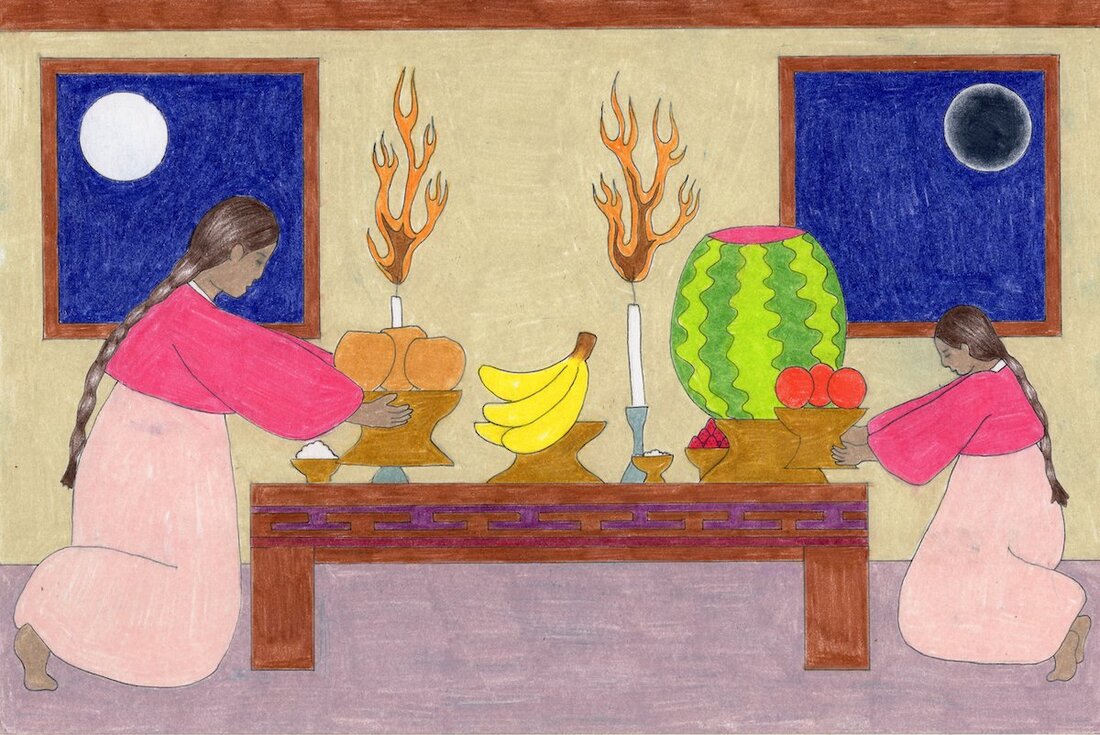Letters from the Editors
|
Before this volume became what it is, we were looking at several different topics to explore, some of which are included in this volume. It took us some time to figure out the throughline between them and how to capture that in a word or short phrase. How do you put to words the tender and diverse experiences of growing up and growing old, of moving through this world with the people we love, or, simply, of being human with dreams for the future? When I first read the phrase “aging in place,” it was in a research journal after googling aging and Korean (I’m not sure what I was looking for). It was not an intuitive phrase for what we were looking for, but it was something that made me pause and think. The more I thought about it, the more it made sense to me in the vast context of our volume. This volume has been a great reminder of how aging requires a kind of openness and grace, especially given the expansiveness—or the possibilities—of how we understand and experience aging. It also requires a kind of strength in the face of not only the structures that push people to the margins, but also of one’s mortality. This volume is the first time we feature the story of a young woman who, up until this summer, lived her life in Korea. She writes about some reflections on her life there. It was also a reminder that being diasporic exists in relation to having a shared homeland and that these connections to home and land (and what it means to grow old in those spaces) are ever-changing, in flux, and continuously being (re)negotiated. Thank you, as always, for joining us in this journey. In hope and solidarity, Harriet |
Aging has become more than just adding a number to the years I’ve lived in this world. It’s become a process of gaining more experiences on how to live in this world. During the year we’ve been planning this volume, I’ve been pondering a lot about my age—what does it mean to be at this age? When Harriet suggested “aging in place” as the theme for all the ideas and conversations we wanted to explore in Volume 3, it also felt very fitting to the questions I’ve been exploring. Aging connotes a personal process of anticipation, excitement, or fear for “growing old,” whereas aging in place takes this individual experience into something more relational and communal. It’s a journey of figuring out how to live as who and what we are, and where we are. And we can only find the responses to these along with and in relation to others. Aging, then, expands to consider evolving, maturing, and changing through time. Each piece in Volume 3 shares a part of this journey. For example, we discover our identity by noticing the joy we feel when visiting the local bookshop and conversing with our neighbours. We examine our body’s physical maturity by looking at those with more life experiences. We comprehend our end of life by practicing familial traditions and commemorating our deceased loved ones. 더불어 사는 세상에서 나의 자리에서 나이 드는 현상은 개인에서 벗어나 함께 걸어가며 부딪히고 알아가는 과정이다. 처음 사는 인생인 만큼 처음 나이를 겪으니 우리는 함께가 필요하다. Aging in place is a complicated journey, and each piece offers a new perspective on how to approach this journey or a familiar exploration reminding us we’re not alone in this confusion. Recently, I came upon actress Youn Yuh-jung’s quote from the travel-reality show Noona Over Flowers that has given an assurance to my pondering: “육십이 돼도 인생을 몰라요. 내가 처음 살아보는 거잖아. 나 67살이 처음이야. 내가 알았으면 이렇게 안 하지. 처음 살아보는 거기 때문에 아쉬울 수밖에 없고 아플 수밖에 없고, 계획을 할 수가 없어. 그냥 사는 거야." "You don’t know what will happen to your life even in your 60s, because it’s your first time. It’s my first time being 67 years old. If I knew how it would be, I wouldn’t live like this. But it’s my first time, so I will regret and feel hurt, and I can’t plan it. I just live it.” For the future, mirae. |
Cover Art:
Cory Feder is a Korean-American illustrator, animator, musician, dancer and sculptor. Raised in Denver, Colorado, Cory’s work explores identity through community and - inversely - community through identity. Her work explores human tenderness through nature, folklore, and the divine. Through her re-interpretations of Korean and Jewish mythology, woven with her own interactions with the natural world, Cory builds a bridge between the past and the present; present and the future. | Website: coryfeder.com, IG @yesolpictures


